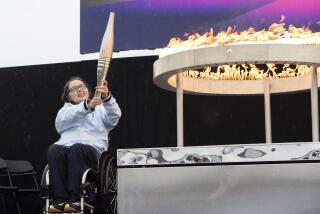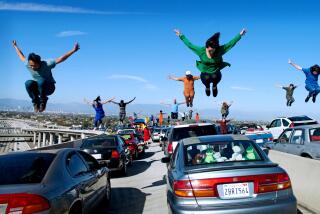Olympic Torch Sets Town Aglow
- Share via
HEBER CITY, Utah — The Olympic flame swept through mountainous, rural Utah on Thursday, then made a downhill run into the Salt Lake Valley on the eve of tonight’s opening ceremonies of the Winter Games.
Despite frigid temperatures, thousands of people, including members of school and military bands, stood along streets and historic railroad tracks to greet the flame. Some were so moved by its sight that they cried, while others cheered loudly and raucously shook cow bells to signal the torch’s arrival.
“This is an absolutely great sight for this valley,” said Terry Shoemaker, superintendent of the Wasatch County school district. “We are all very patriotic here.”
Heber City has about 5,000 people and is situated in the middle of alpine countryside dotted with horse and cattle farms. The town was a late entry into the Olympic Games. Soldier Hollow, a rolling and partly wooded sheep pastureland about 5 miles west of here, was the last of the venues to be identified for the Winter Games--the site for cross-country skiing and the biathlon.
Residents have since spruced up the town’s main street with banners, repaired sidewalks and constructed a 15-foot-high caldron in front of Rocky Mountain Middle School to remind the community of its role in the Games. The caldron resembles an outdoor patio heater topped with the Olympic snowflake symbol.
The flame got here from Soldier Hollow by hitching a 20-minute ride in a caldron atop a railroad flatcar pulled by three century-old steam engines. At every rural crossing, motorists got out of their vehicles and lined the tracks, waving not just at the flame but at the various dignitaries and schoolchildren who were invited to ride on what’s affectionately known here as the Heber Creeper.
When it arrived in town, the flame was transferred to schoolteacher Mary Clark, who after her 0.2-mile walk passed it on to her daughter, Celeste Clark, 18, who has Down’s syndrome.
“I’ve been preparing to let go of her, and now that she’s 18, the fact that she is carrying the Olympic torch is so very symbolic,” the mother said. “I cried most of the way before I gave the flame to her. I just kept shouting, ‘Go, Celeste, go!’ ”
The next torchbearer also cried.
Cheryl Hardy, 50, another school district employee, said she carried the flame in memory of her deceased brother, David Simpson, who 20 years ago campaigned for freestyle skiing to be included in the Olympics, as it is now.
“This is the highlight of my life, and emotionally it’s hard to talk about it,” Hardy said. “I see the Olympics bringing the nation together, and for me to have a small part of that is more than I can believe.”
Debbie Smith, 46, a horse trainer, said she was thrilled to hear the whistle of the steam engine, her signal to drop everything and watch the flame pass. “What it tells me is that the Olympics are really here! It came from Greece and now it’s going through our town!”
Into the dark and cold of night, the flame was being carried toward a downtown park in Salt Lake City, where city officials hosted a free festival with music and fireworks. Paralympic champion skier Chris Waddell ignited a caldron in downtown Salt Lake to trigger the fireworks before tens of thousands of people.
The torch relay was launched Dec. 4 from Atlanta, the last U.S. host of the Olympic Games, and covered 13,500 miles in 46 states. About 11,500 torchbearers were selected through contests, lotteries, nominations and corporate sponsors. The flame also traveled by automobile, airplane, dog sled, skier, sleigh, snowmobile, ice skater and covered wagon.
*
MORE INSIDE
Olympic medals: The makers of medals for the Winter Games hope they’ve designed a work of art. B1
Getting there: The competition to get to the Olympics is tough--even for bus drivers. B6
More to Read
Go beyond the scoreboard
Get the latest on L.A.'s teams in the daily Sports Report newsletter.
You may occasionally receive promotional content from the Los Angeles Times.






